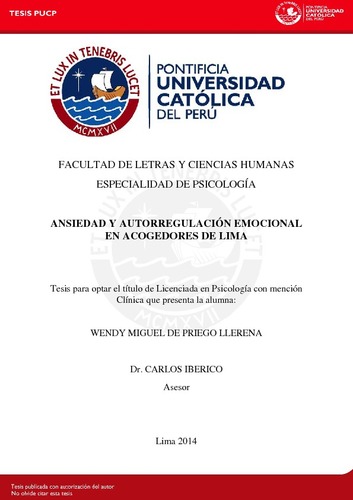| dc.contributor.advisor | Iberico Alcedo, Carlos Simón | es_ES |
| dc.contributor.author | Miguel de Priego Llerena, Wendy | es_ES |
| dc.date.accessioned | 2014-08-28T01:49:03Z | es_ES |
| dc.date.available | 2014-08-28T01:49:03Z | es_ES |
| dc.date.created | 2014 | es_ES |
| dc.date.issued | 2014-08-27 | es_ES |
| dc.identifier.uri | http://hdl.handle.net/20.500.12404/5544 | |
| dc.description.abstract | La ansiedad es inherente a las personas y la forma en que uno se autorregula emocionalmente tiene repercusiones importantes en la adaptación del individuo a su medio ambiente. Es por ello que el presente estudio tiene como objetivo conocer la relación entre ambas variables psicológicas en un grupo de psicoterapeutas que intervienen bajo el encuadre de la acogida en Lima. La muestra está compuesta por 25 acogedores entre 22 y 63 años a quienes se evaluó utilizando el inventario de Ansiedad Rasgo y Estado, IDARE, y el Cuestionario de Autorregulación Emocional en la versión adaptada para el Perú (ERQP) de Gargurevich y Matos (2010). Resultó que no correlacionaron significativamente los tipos de ansiedad, estado y rasgo; con las formas de autorregulación emocional, supresión y reevaluación cognitiva. Sin embargo, se analizan las posibles explicaciones, lo que contribuye al conocimiento de los acogedores y con esto se aportan datos importantes para las asociaciones que brindan este servicio a la comunidad. | es_ES |
| dc.description.abstract | Anxiety is inherent in people and how an individualemotionally regulates oneself has important implications for his/her adaptation to its environment. Therefore, the purpose of this study is to determine the relationship between these two psychological variables in a group of psychotherapists in Lima, involved in the framing of the “acogida”.The sample consists of 25 “acogedores” between 22 and 63 years who were assessed using the State Trait Anxiety Inventory (STAI) and the Emotional Regulation Questionnaire Peruvian version (ERQP) byGargurevich and Matos (2010).It turned out that there was no significant correlation between the types of anxiety, state and trait, and the forms of emotionalregulation, cognitive reappraisal and suppression. However, the possible explanations are analyzed, contributing knowledge about these “acogedores” and provide important data for organizations that provide this service to the community. | es_ES |
| dc.language.iso | spa | es_ES |
| dc.publisher | Pontificia Universidad Católica del Perú | es_ES |
| dc.rights | Atribución-NoComercial-SinDerivadas 2.5 Perú | * |
| dc.rights | info:eu-repo/semantics/openAccess | es_ES |
| dc.rights.uri | http://creativecommons.org/licenses/by-nc-nd/2.5/pe/ | * |
| dc.subject | Emociones | es_ES |
| dc.subject | Ansiedad | es_ES |
| dc.subject | Control (Psicología). | es_ES |
| dc.title | Ansiedad y autorregulación emocional en acogedores de Lima | es_ES |
| dc.type | info:eu-repo/semantics/bachelorThesis | es_ES |
| thesis.degree.name | Licenciado en Psicología Clínica | es_ES |
| thesis.degree.level | Título Profesional | es_ES |
| thesis.degree.grantor | Pontificia Universidad Católica del Perú. Facultad de Letras y Ciencias Humanas. | es_ES |
| thesis.degree.discipline | Psicología Clínica | es_ES |
| renati.discipline | 313026 | es_ES |
| renati.level | https://purl.org/pe-repo/renati/level#tituloProfesional | es_ES |
| renati.type | http://purl.org/pe-repo/renati/type#tesis | es_ES |
| dc.publisher.country | PE | es_ES |
| dc.subject.ocde | https://purl.org/pe-repo/ocde/ford#5.01.00 | es_ES |






